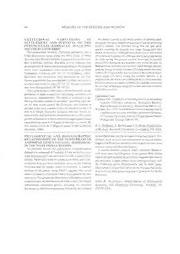
Latitudinal variations in settlement and survival of the pedunculate barnacle, Pollicipes polymerus Sowerby PDF
Preview Latitudinal variations in settlement and survival of the pedunculate barnacle, Pollicipes polymerus Sowerby
94 MEMOIRS OF THE QUEENSLAND MUSEUM LATITUDINAL VARIATIONS IN We define survival as the mean number ofj uvenile/adult SETTLEMENT AND SURVIVAL OF THE divided by the mean number ofs pat/adult from the preceding PEDUNCULATE BARNACLE, POLLICIPES month9s sample. The rationale being that the spat grow POLYMERUS SOWERBY quickly reaching the juvenile size range during their first The pedunculate barnacle, Pollicipes polvmerus. has a month of existence. Although settlement occurs year round broad distribution range along the West Coast of North off La Jolla with peaks (133-290 spat/adult) occurring during America, from British Columbia, Canada, to Punta Abreojos. the early spring, the percent survival from spat to juvenile Baja California, Mexico. Brooding activity indicates two peaks (19°) during the late autumn-early winter months. At geographically disparate races corresponding to the cold and Bodega Head, settlement occurs trom April through January warm water temperature zones north and south of Point peaking during the early summer (22.6 spat/adult) and early Conception, California (34° 16° 12" N) (Cimberg, 1981). winter (26-37 spat/adult). Survivorship in the northern popu- Settlement and recruitment were monitored on two Cal- lation peaks (37-64%) during the summer months. It is ifornia populations that corresponded to these two races: a proposed that the lower survivorship in the La Jolla race may be due to desiccation and/or temperature stresses exerted on southern race from La Jolla (32° 52° 12" N) and a northern the recently settled spat along the warmer and drier southern race from Bodega Head (38° 18° 30" N). California coastline. The cyprid larvae of Pollicipes settle preferentially on the peduncles of adult conspecifics facilitating settlement and Literature Cited Tecruitment measurements. The index of settlement is de- Cimberg 1981. Variability in brooding activity in the stalked fined as the mean number of spat/adult; spat being individu- barnacle Pollicipes polymerus. Biological Bulletin. als <1 mm rostro-carinal (R-C) length. Recruitment is Marine Biological Laboratory, Woods Hole 160: 31-32. defined as the mean number ofj uvenile barnacles in the 1-9 Hoffman, D.L. 1989. Settlement and recruitment patterns of mm R-C length. Generally barnacles this size remain at- a pedunculate barnacle, Pollicipes polymerus Sowerby, tached to the adult peduncles. From observations off La Jolla, off La Jolla, California. Journal of Experimental Marine growth of barnacles in newly established aggregates is quite Biology and Ecology 125: 83-98. rapid reaching mean R4C lengths in less than one month. By five months a mean R-C length of almost 15 mm is attained D.L. Hoffman, N. Bertha andJ .G . Blom, Department (Hoffman, 1989), of Biology, Bucknell University, Lewisburg, PA. USA. PHYLOGENETIC AND BIOGEOGRAPHIC isopod Bahalana, and the decapod shrimp Agostocaris. Pre- RELATIONSHIPS OF THE SUBTERRANEAN liminary track analysis and observations on natural history AMPHIPOD GENUS BAHADZIA (HADZIIDAE) suggest that Bahadzia and these other stygobiont taxa, have IN THE WEST INDIAN REGION shared a similar distributional history. As presently known, the subterranean amphipod genus A second cladistic analysis, which compares Bahadzia Bahadzia is composed of 7 species: 4 from anchialine caves with most other hadziid genera in the greater West Indian in the Bahamas and Turks and Caicos Islands, | from shallow region, strongly supports the possibility suggested previously (mostly freshwater) wells in southeastern Haiti, and 2 (de- that Bahadzia is more closely allied phylogenetically with scriptions in prep.) from anchialine caves on the Yucatan the freshwater genus Mayaweckelia and its sister genus Peninsula and the nearby island of Cozumel. A cladistic (description in press) from caves on the Yucatan Peninsula, analysis of the genus, using PAUP, suggests that nested than with any other genus or group of genera in the family subsets of species correspond closely to geographically sep- Hadziidae. arate areas. The geographic distribution of Bahadzia is nearly congruent with the distributions of 4 other small, monotypic John R. Holsinger, Department of Biological subterranean crustacean genera, including the remipede Sciences, Old Dominion University, Norfolk, VA Speleonectes, the thermosbaenacean 7ulumella, the cirolanid 23529, USA.
